How to live with the virus. Gimbe Report

The grip of the restrictions is loosening and the summer is approaching, however it remains necessary not to let your guard down and to keep some precautions to learn to live with the virus
The curve of new infections stabilizes and we are preparing to live with the virus, but cases are increasing both in ordinary wards and in intensive care. Here are the data from the Gimbe Foundation and some recommendations for this new phase.
THE EPIDEMIOLOGICAL TREND
Gimbe's independent monitoring detects in the week 23-29 March 2022, compared to the previous one, a substantial stability of new cases (504,487 vs 502,773) (figure 1) and deaths (953 vs 924) (figure 2).
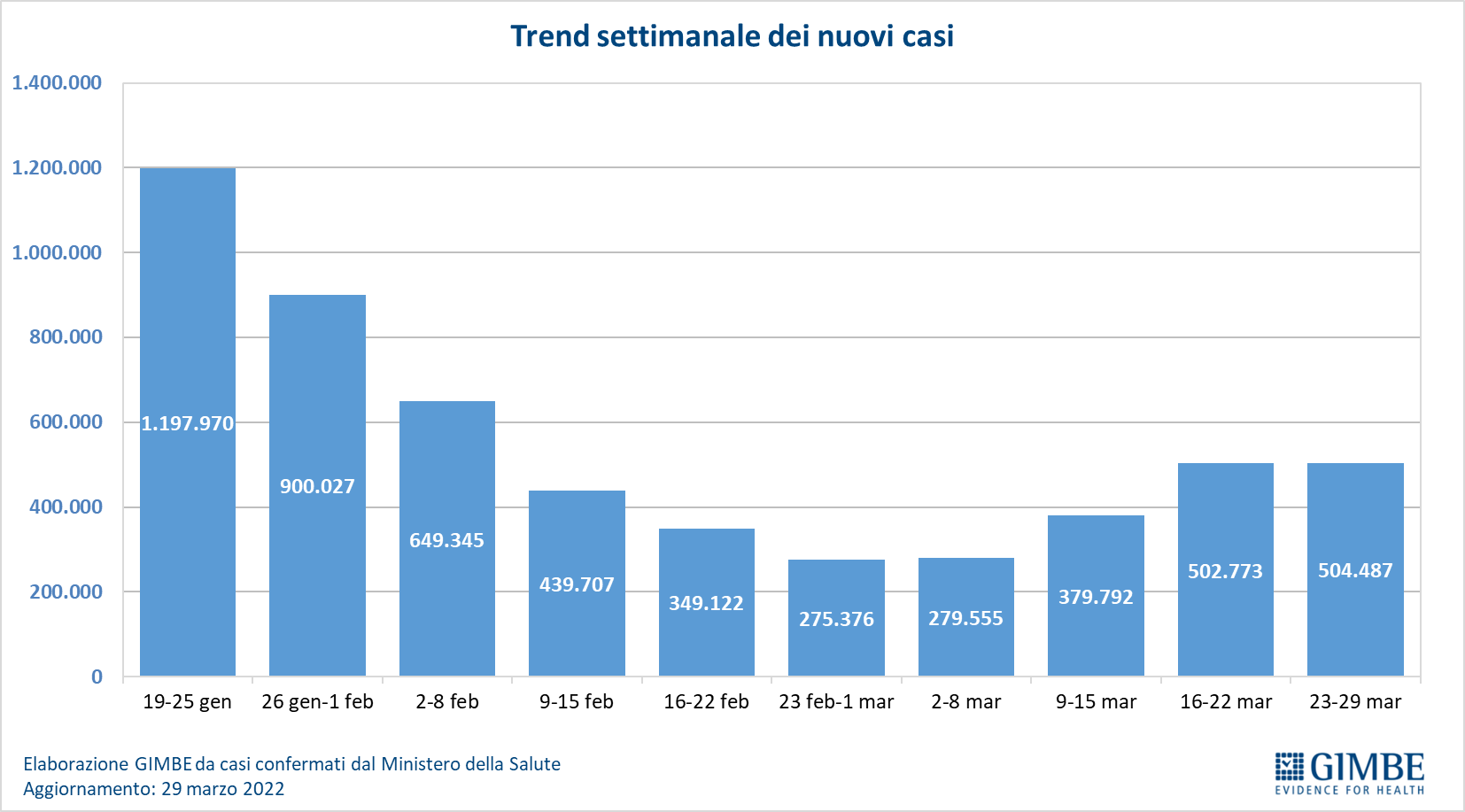
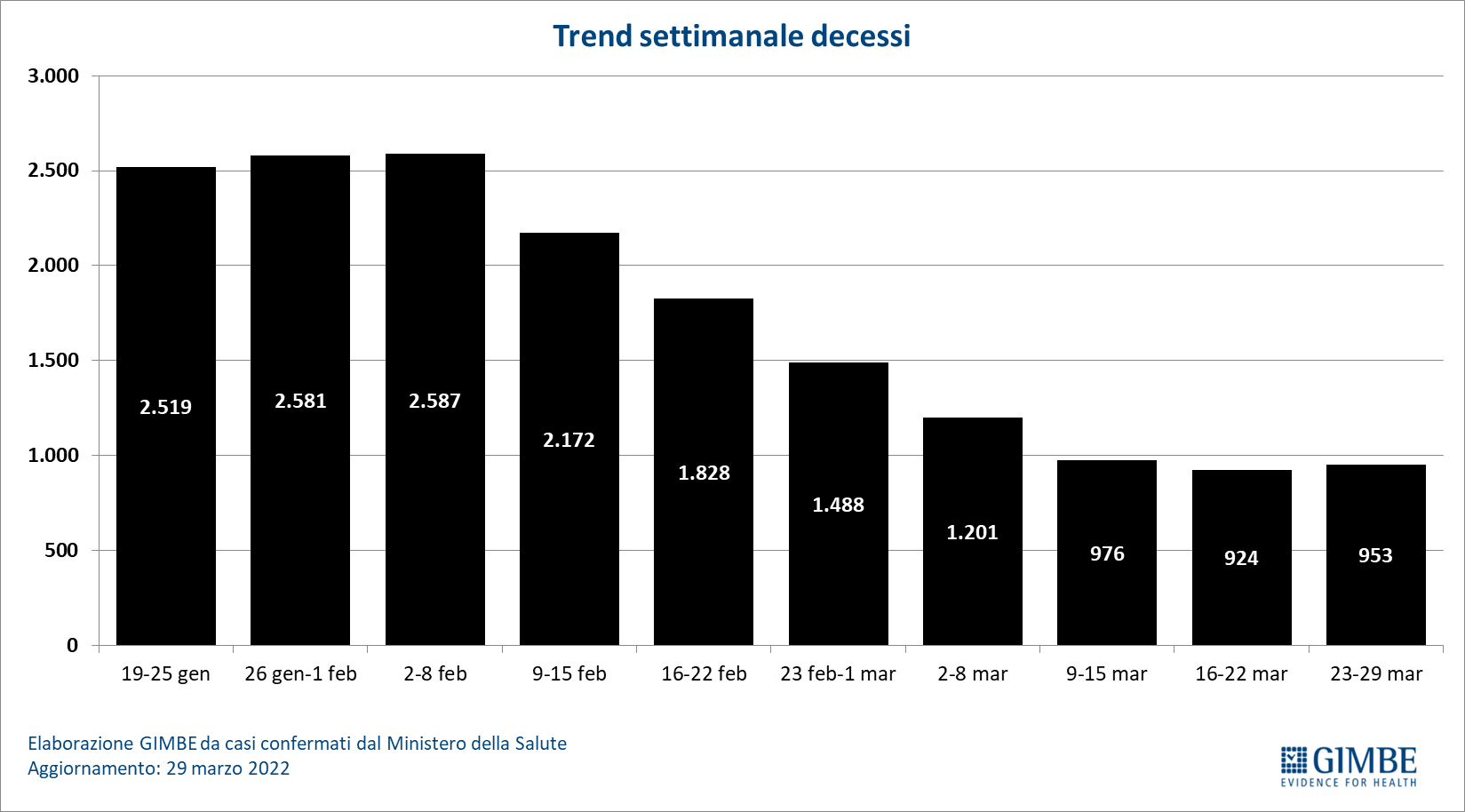
On the other hand, currently positive cases are increasing (1,266,878 vs 1,200,607), people in home isolation (1,256,651 vs 1,191,183), hospitalizations with symptoms (9,740 vs 8,969) and intensive care (487 vs 455).
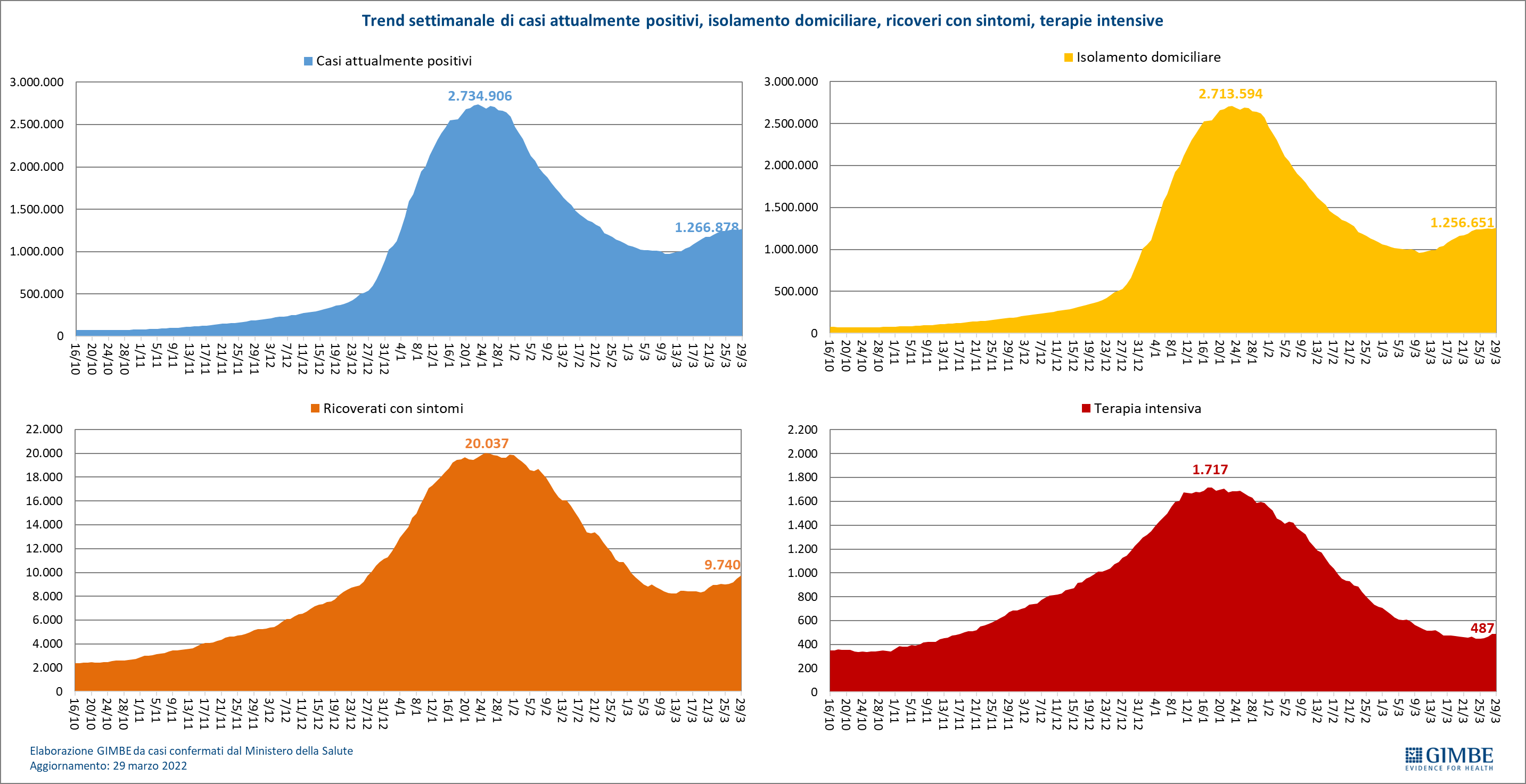
NEW CASES ESTABLISHED
"After two weeks of sharp increase – declared Nino Cartabellotta, president of the Gimbe Foundation – the new weekly cases seem to have stabilized at around 500,000, with an increase of 0.3% and a 7-day moving average that remains steady around to the 72 thousand cases. However, at this moment it is difficult to make predictions, both due to the heterogeneous situation at the regional level, and because in the large Northern Regions, where over a third of the Italian population resides, there are currently no signs of consistent viral circulation ".
In fact, the report reports, in the week 23-29 March there was a percentage increase in new cases in 10 Regions and a decrease in 11: from + 17.8% in the Autonomous Province of Trento to -16% in Umbria.
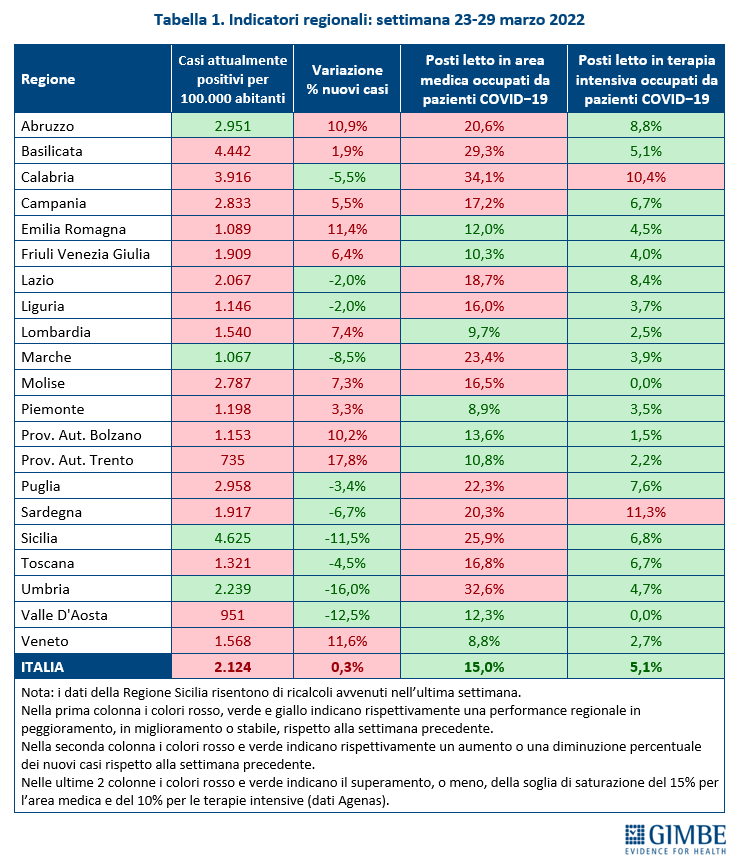
HOSPITALIZATIONS AND DEATH
"On the hospital front – says Renata Gili, Head of Research on Health Services of the Gimbe Foundation – there is a reversal of the trend in the beds occupied by Covid patients in intensive care (+ 7%) and the increase in hospitalizations continues. medical area (+ 8.6%) ".
In particular, according to the report, in the critical area from the minimum of 447 on March 24, the number of beds occupied rose to 487 on March 29; in the medical area, on the other hand, after hitting a low of 8,234 on 12 March, they rose to 9,740 on 29 March.
As of March 29, the national employment rate for Covid patients was 15% in the medical area and 5% in the critical area, a slight increase compared to the previous week.
13 Regions exceed the 15% threshold in the medical area, with the Calabria Region reaching 34.1%; Calabria and Sardinia exceed the 10% threshold in intensive care.
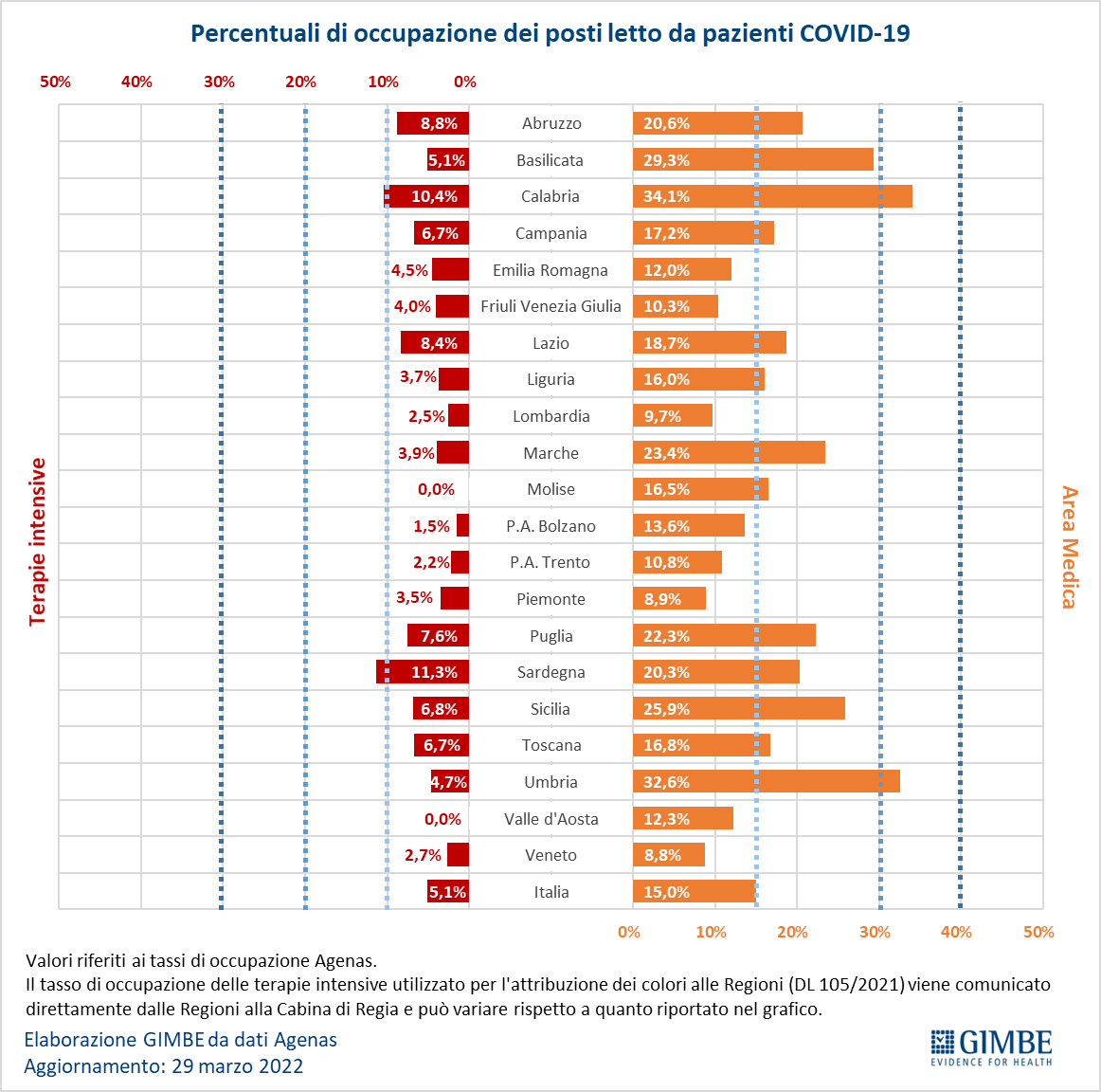
After six consecutive weeks the number of deaths stops: 953 in the last 7 days (of which 64 referred to previous periods), with an average of 136 per day compared to 132 in the previous week.
THE VACCINATION CAMPAIGN IS ON THE POLE
The encouraging data and the easing of temperatures make us look with optimism to the months to come, however, the virus has not disappeared and the vaccination campaign, to use Cartabellotta's words "is now at stake" despite the fact that there are still over 4.4 million of people who can be vaccinated with the first dose and 2.8 million with the booster dose.
"The vaccination coverage rates – underlines the president Gimbe – in the last month have registered very small increases". Covers with at least one dose mark a measly +0.2, going from 85.4% to 85.6%; those with a full cycle increased by only 0.6 percentage points from 83.3% to 83.9%.
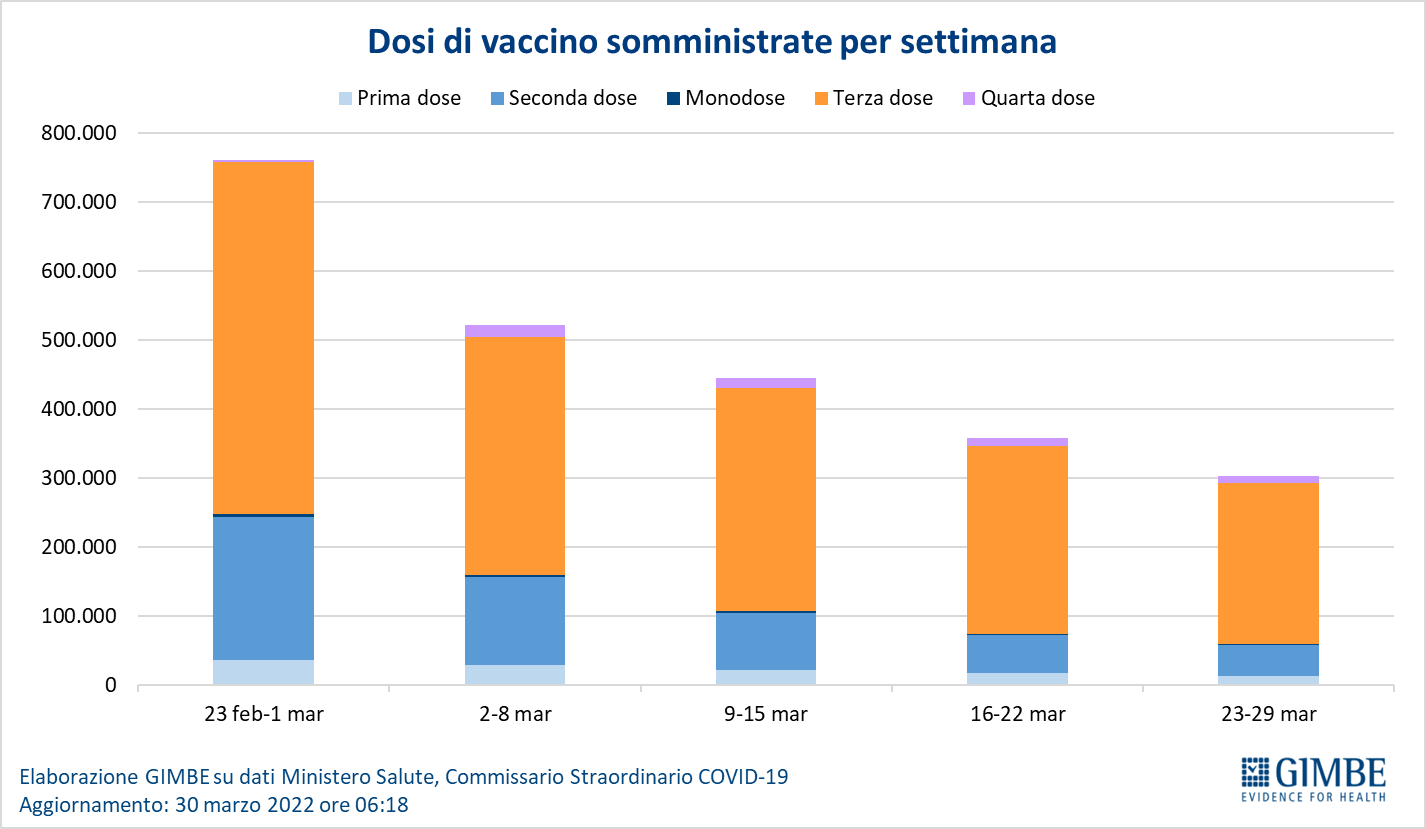
The coverage of third and fourth doses also proceeds slowly with, respectively, increases equal to 2.8 and 7.3 percentage points (respectively 80.4% vs 83.2% and 0.1% vs 7.4%) despite the later start and the extensive vaccinable audience.

WHY NOT UNDERESTIMATE THE RISKS
“For some time now – added Cartabellotta – the political narratives and the perceptions of the population tend to identify the expiry of the state of emergency with the end of the pandemic, which obviously cannot coincide with a bureaucratic deadline. In fact, thanks to the reckless decrease in attention that led to the stalling of the vaccination campaign and the relaxation of individual precautions, as of March 30th there were more than 500,000 new cases in 7 days with over 1.26 million positive cases in two weeks which resulted in an increase of over 1,500 places in the medical area and reversed the trend of intensive care. With almost a thousand deaths a week ".
“This is why – continues President Gimbe – we need to look to the near future with optimism and confidence, but also with prudence and responsibility, given the uncertainties about possible new variants and duration of vaccination coverage. For its part, the Gimbe Foundation – which will continue to publish the weekly monitoring even after March 31 – formulates some recommendations for coexistence with SARS-CoV-2, in order to guarantee a summer as quiet as possible, and above all to arrive get ready for the next autumn-winter season ".
TIPS TO LIVE WITH THE VIRUS AND AVOID A NEW WAVE
To live with the virus after March 31, Gimbe suggests:
- complete the vaccination course with three doses (four for immunocompromised people);
- continue to wear the mask in public places indoors, outdoors in crowded conditions and when in contact with fragile people;
- swab in case of symptoms compatible with Covid-19;
- respect the isolation in case of positivity or in the presence of symptoms compatible with Covid-19 while waiting to perform the swab.
To the individual suggestions are added system suggestions, such as:
- continue to carry out vaccination campaigns for all subjects eligible for vaccination;
- maintain the obligation to wear masks indoors and in crowded places until the circulation of the virus has not been significantly reduced;
- implement training interventions for general practitioners to promptly prescribe the antiviral drugs available to those at increased risk of severe disease;
- implement structural interventions to improve the ventilation of closed spaces such as public offices or classrooms, for which national guidelines are still awaited;
- enhance the sequencing system of viral variants;
- plan the autumn vaccination campaign, monitoring the vaccination efficacy on severe disease for the purpose of a possible administration of the second booster (fourth dose) for subjects at greater risk.
HOW MANY PEOPLE COULD STILL GET VACCINATED
Continuing with vaccinations remains the most effective solution to avoid a new wave, especially once the summer has passed. However, to date, as Cartabellotta also recalled, there are still 6.94 million people who have not received even a dose of the vaccine, of which 2.51 million are only temporarily protected as they have recovered from Covid-19 for less than 180 days. As a result, there are approximately 4.43 million people who can currently be vaccinated, a figure that continues to ignore the exemptions of which the exact number is not known.
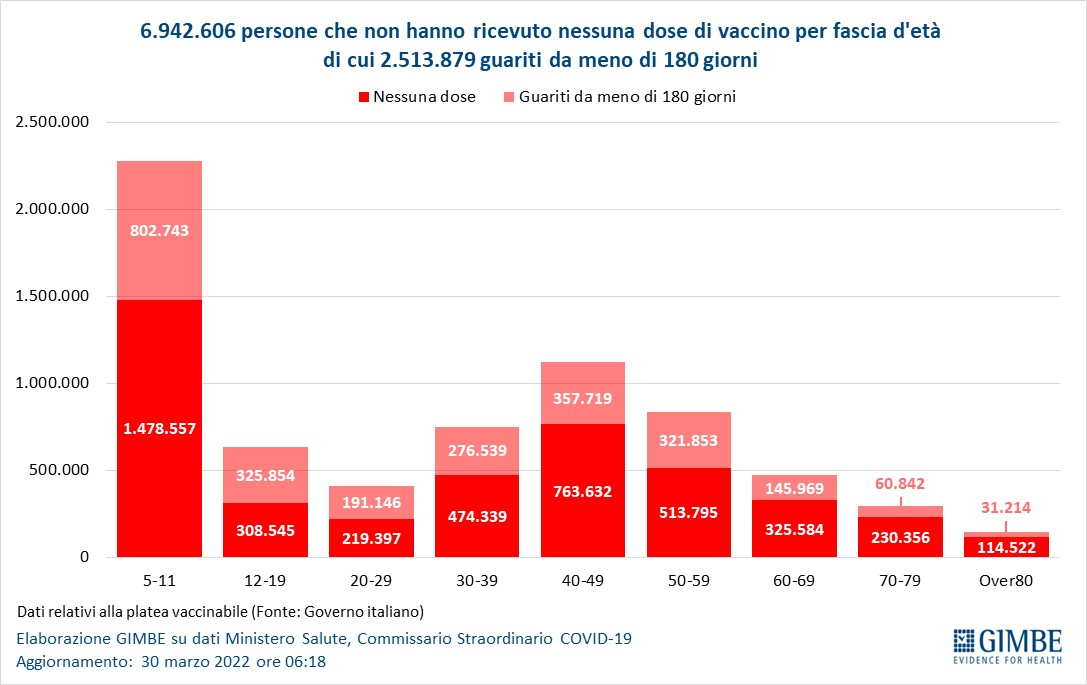
FOCUS THIRD DOSE
As of March 30, the report reads, 38,778,598 third doses have been administered, with a 7-day moving average of 33,389 doses per day. Based on the official audience (no. 46,621,748), updated as of March 29, the national coverage rate for third doses is 83.2% with clear regional differences: from 77.8% in Sicily to 86, 8% of the Aosta Valley.
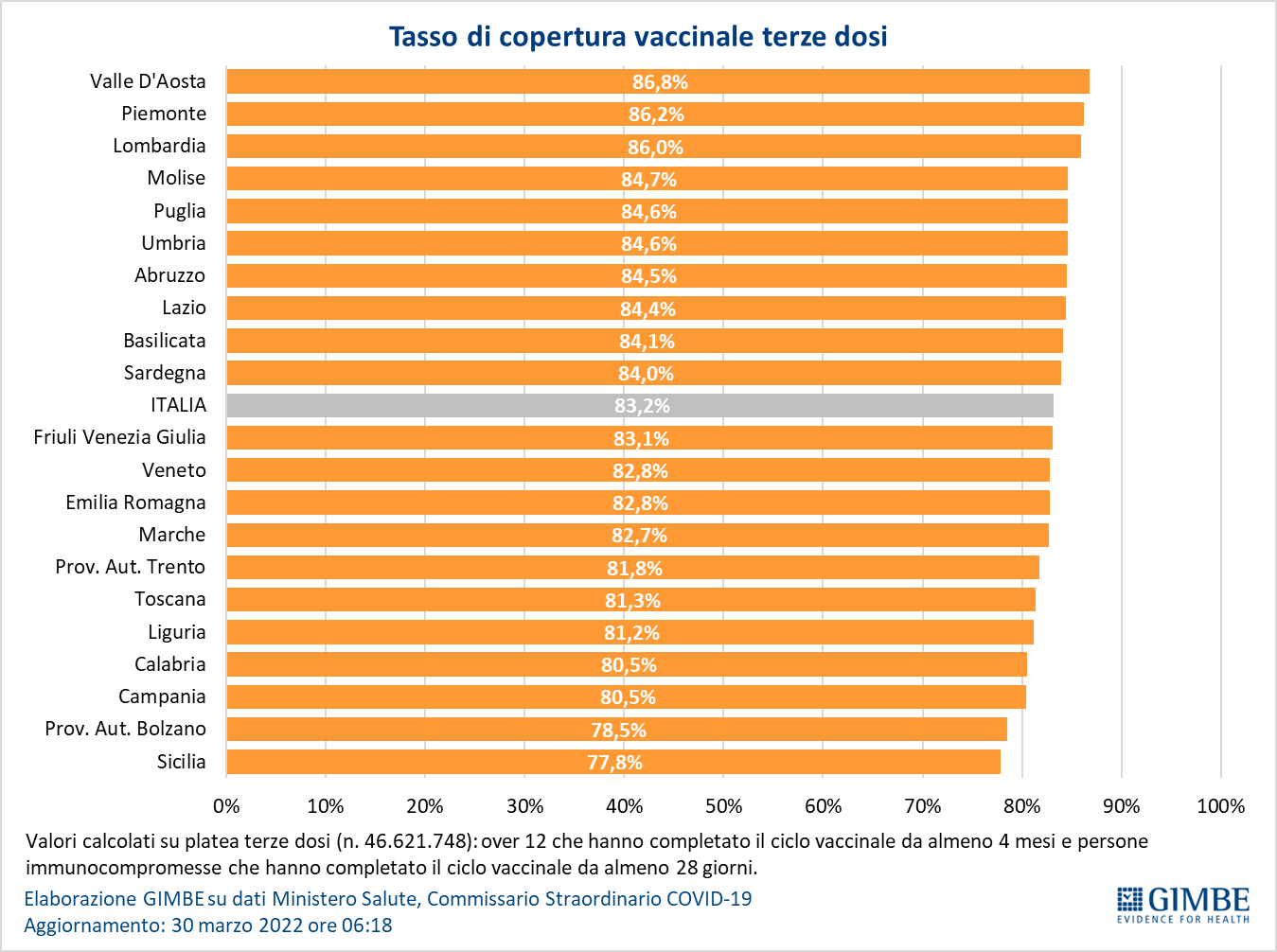
Of the 7,843,150 people who have not yet received the booster dose, 2.86 million may receive it immediately, while 4.98 million who have recovered for less than 120 days are not candidates for it immediately.
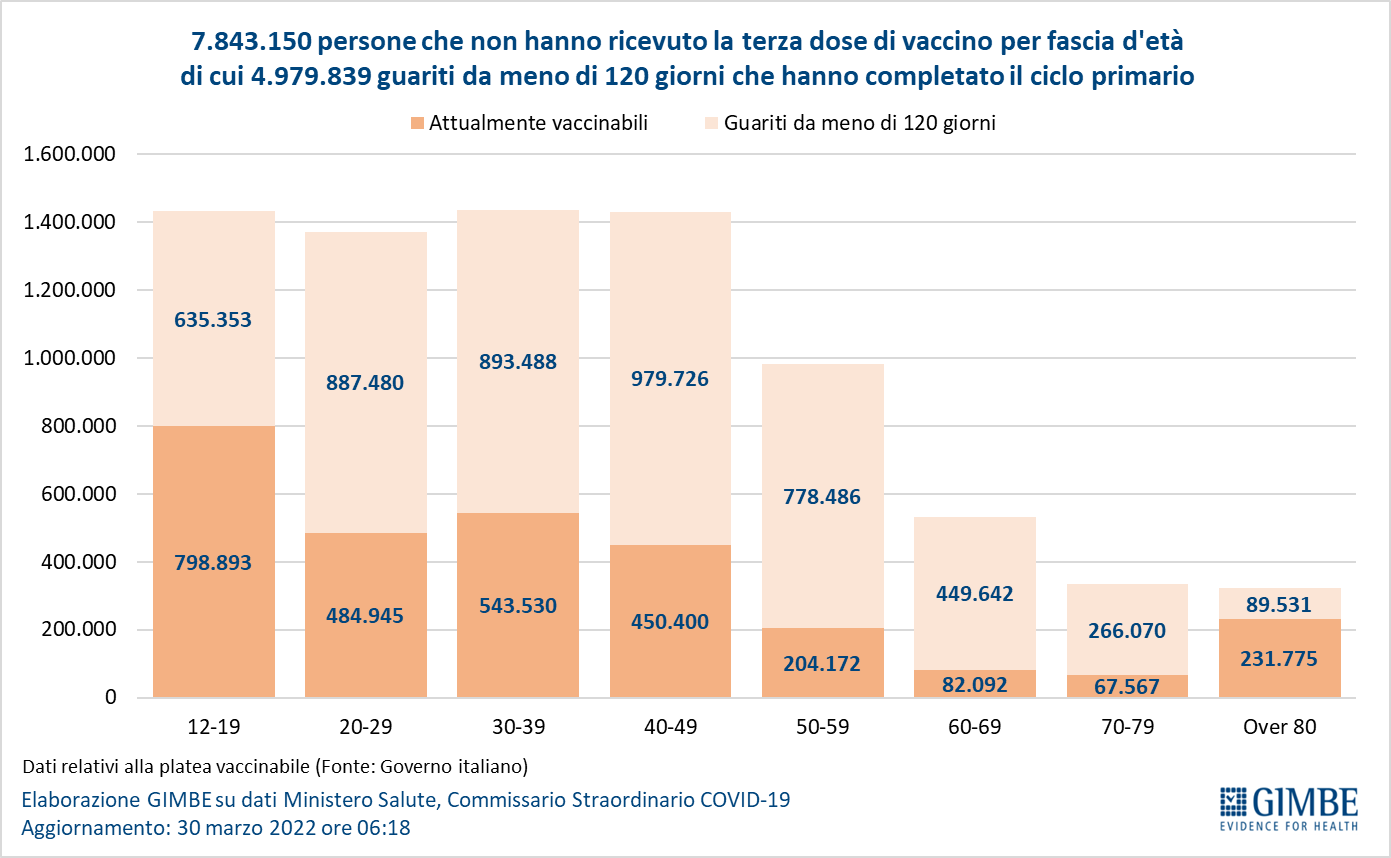
FOURTH DOSE KNOT
As of March 30, according to Gimbe data, 58,545 fourth doses have been administered. According to the official audience (n.791.376), updated on 9 March, the national coverage rate for the fourth doses is 7.4% with clear regional differences: from 0.7% in Molise to 34.5% in Piedmont. .
"One month after the green light for immunocompromised people who need a fourth dose to complete their vaccination cycle – said Cartabellotta – the limited coverage achieved and the regional differences are completely unjustifiable, taking into account that it is an audience well defined, made up of people known to the ASLs to which they belong and can be reached via an active call ".
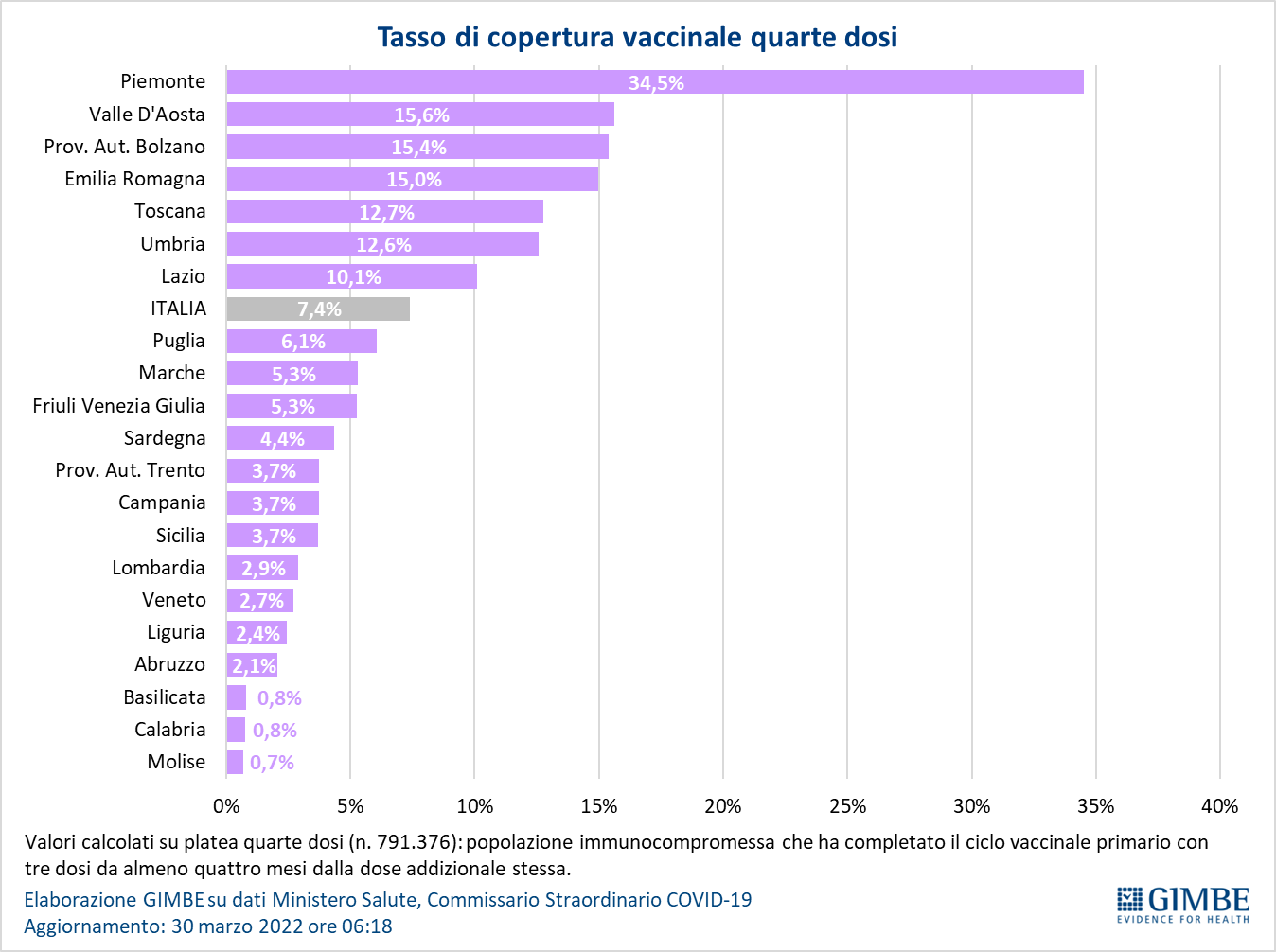
On whether and how to proceed with the fourth dose Cartabellotta stated that "at present the scientific evidence on the efficacy of the fourth dose of the vaccine is fragmented and limited, but it seems to show a protective effect against serious illness in older people".
"This is why, – concludes President Gimbe – regardless of the need shared by the European ministers for health to arrive at a single proposal for all countries, given the high number of deaths among those over 80 vaccinated with boosters, it is reasonable to give in Italy the green light for the administration of the fourth dose in over eighty, in a phase where high viral circulation and a decrease in vaccination coverage against serious illness coincide ".
EFFECTIVENESS AND VACCINAL COVERAGE
The Foundation, in fact, reiterate that overall in people vaccinated with a complete cycle (plus any booster dose), compared to those not vaccinated, in the various age groups the incidence of diagnoses is reduced (by 41.4-69.1 %), but above all serious illness (59.1-87.5% for ordinary hospitalizations; 73.8-90.4% for intensive care) and death (67-91.2%).
Data from the Higher Institute of Health (ISS) also show that the effectiveness on diagnosis progressively decreases from 50.4% for vaccinated with two doses within 90 days to 47.5% for vaccinated for more than 120 days, for then go back to 70% after the recall; and the efficacy on severe disease increases from 73.2% for those vaccinated with two doses within 90 days to 75.6% for those vaccinated for more than 120 days, and then rises again to 91.3% after the booster.
This is a machine translation from Italian language of a post published on Start Magazine at the URL https://www.startmag.it/sanita/come-convivere-con-il-virus-report-gimbe/ on Thu, 31 Mar 2022 10:33:50 +0000.
